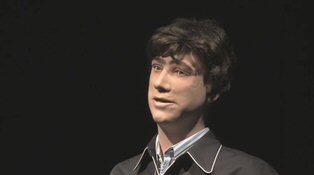Meet Julio — the singing robot.
“Voice of Julio” is an art project by David Byrne (Mr. Big Suit from the rock band, Talking Heads) and David Hanson (creator of “conversational character robots”) currently on exhibit at the “Machines and Souls” exhibition in Madrid (ends mid-Oct 2008). Julio is made of electrons and rubber, but sings with Byrne’s voice, and his face is programmed to mimic the gestures and expressions of a vocalist. In his project description, “Julio the Uncanny,” Byrne writes:
Knowing that singing elicits an emotional reaction from a listener and observer, I sense that encountering Julio might push some very odd buttons….We think of seeing and looking as something optical, something the eyes do. But actually seeing something, and recognizing it, is a lot more than that — it is the act of “naming” the thing the eyes are locking on to. It involves other meta brain functions that often have nothing to do with optics or the muscles controlling the eye. If seeing were just the visual and eye-muscle behavior, then isn’t that the same as what Jules does? And then isn’t singing, and displaying the attendant emotions, the same as what Julio does?
We tend to think that our emotions live inside — in our “hearts” and minds…I think it’s more complicated and more confusing than that.
Byrne discusses the uncanny effect of simulacra — the robot’s human-like appearance — but what strikes me about the premise of Byrne’s installation is the focus on song — utterance — as the actual source of indeterminacy. I think the “strange familiarity” of hearing a voice you might dimly recognize from popular culture — Byrne’s — originating from an inorganic medium might be what accounts for the uncanny effect more than just the cognitive dissonance of perceiving a combination of the human and inhuman. The sound of popular culture is enmeshed in the “organic” vocalizations — an echo from days gone, radio stations played, CDs danced to — nostalgia returned as future tech. Perhaps it is this temporal contradiction that enhances, if not accounts for, das Unheimliche.
On singing and the uncanny, Byrne writes:
Like many animals, humans sing for pleasure, for sex, for attention, to express pain, to relieve angst and to join and participate in a social group. All of these urges seem, if not uniquely human, at least not at all machine like. To see machines mimic these aspects of human life, is to watch some part of our imagined souls being appropriated.
You can watch a video in Byrne’s recent blog entry about the role of the soul in all of this, “Machines and Souls (Máquinas y Almas)” and then see (and hear) Julio in action to judge for yourself.
